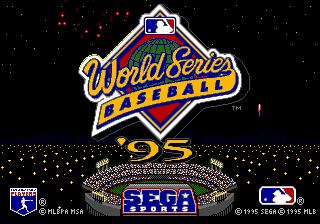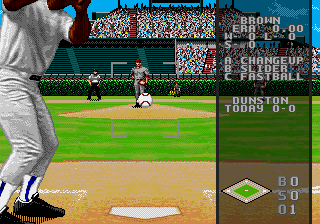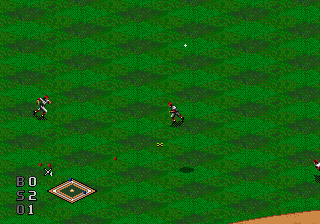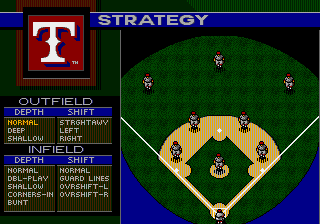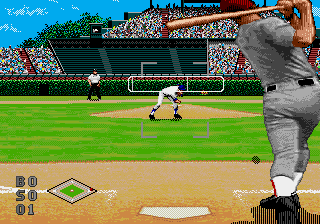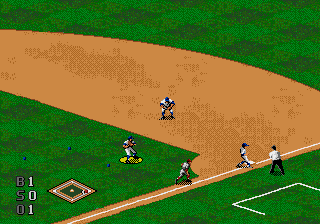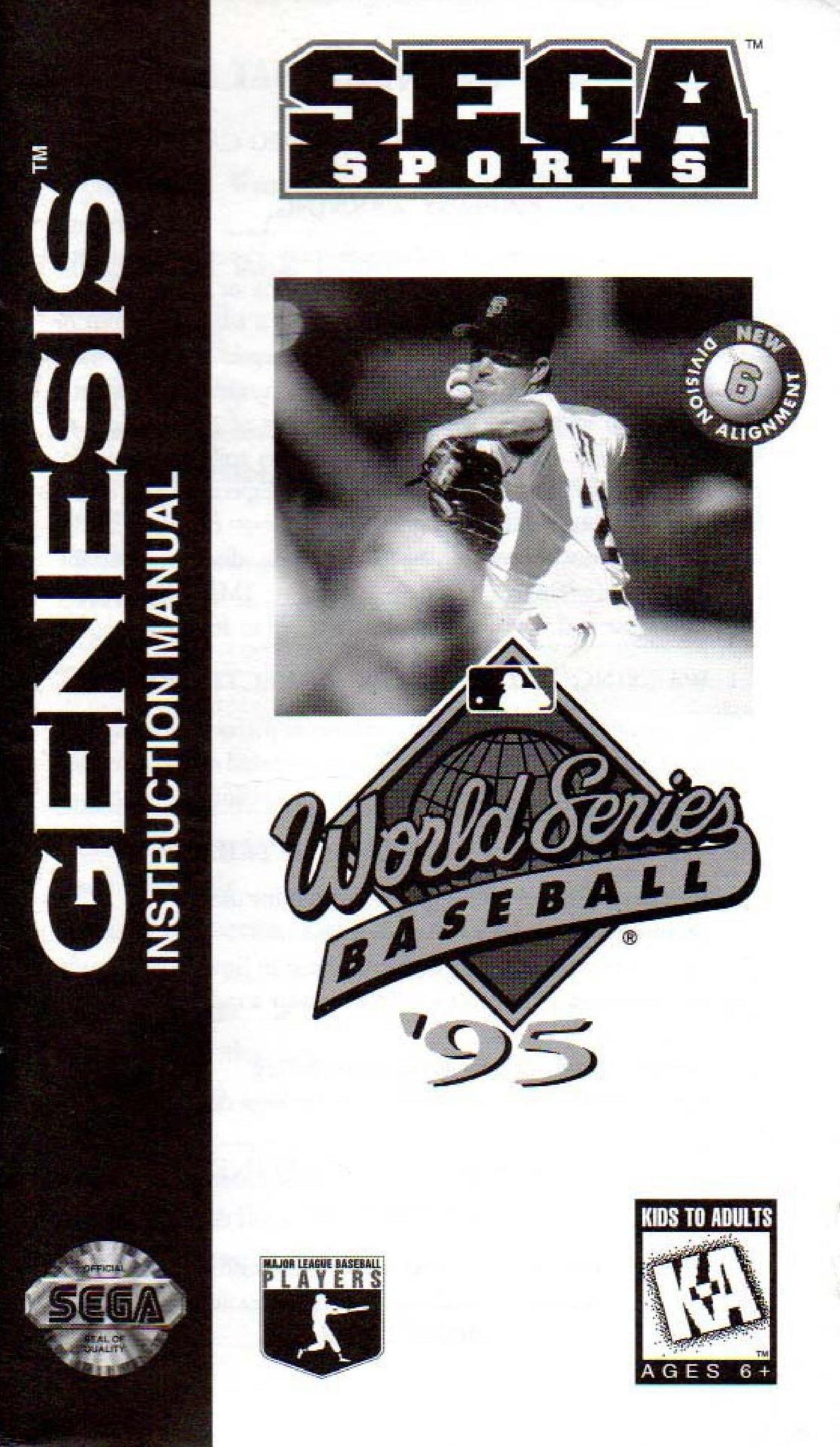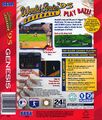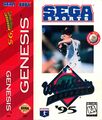World Series Baseball '95 (Mega Drive)
From Sega Retro
- For the Sega Game Gear version, see World Series Baseball '95 (Game Gear).
| World Series Baseball '95 | ||||||||||
|---|---|---|---|---|---|---|---|---|---|---|
| System(s): Sega Mega Drive | ||||||||||
| Publisher: Sega | ||||||||||
| Developer: BlueSky Software | ||||||||||
| Licensor: Major League Baseball Properties, Major League Baseball Players Association | ||||||||||
| Sound driver: GEMS | ||||||||||
| Peripherals supported: Six Button Control Pad | ||||||||||
| Genre: Sports (baseball) | ||||||||||
| Number of players: 1-2 | ||||||||||
|
World Series Baseball '95 is a Sega Mega Drive baseball game and is part of Sega's World Series Baseball franchise.
A Sega 32X version was advertised in North America, but was likely reworked to become World Series Baseball Starring Deion Sanders.
Contents
Gameplay
The game adds numerous new features and modes to the previous entry. Players can choose from all 28 teams, with rosters updated to the 1995 MLB season, and all 28 ballparks. Furthermore, the game adds several special teams: the American League Stars, National League Stars, and MLB Stars (consisting of the best players from each league or from both leagues) and the American League Legends, National League Legends, and MLB Legends (all-star teams including historical players such as Lou Gehrig). Batting now uses a "batting bar" resembling a bat rather than the circular indicator of the previous game. The spoken commentary of the previous game has been redone (and reduced in quantity).
- Exhibition: A single game against a human or computer player. The player can also watch two computer-controlled teams play. Assigning control to a human is done before the game by moving the player to a team with
 or
or  , then the game is started with START .
, then the game is started with START . - League: Plays a season of games that culminate in the World Series. The player can choose the number of games (13, 26, 52, 104, or a full 162 games) and the number of divisions (4 or 6). The game adds the ability to draft and trade players and a mid-season All-Star Game (whose members are chosen based on the player's season). The game uses a battery backup to save the player's progress.
- Playoffs: A truncated season with only the play-offs. Progress in this mode is also saved using the battery backup.
- Batting Practice: The player practices batting. There are no outs in this mode. The player can select a left- or right-handed pitcher, a left- or right-handed batter, the type of pitch, and the venue.
- Home Run Derby: Players have 10 attempts to hit as many home runs as possible. A missed attempt is a hit that is not a home run; there are no strike-outs. This mode can be played by up to 8 players taking turns.
- Classic Home Run Derby: This mode is a home run competition that retains outs and innings. Like a standard baseball game, the player pitches during one half of the inning and hits in the other half, but there is no fielding or baserunning. The player with the most home runs after nine innings is the winner. It can be played by one or two players.
The scoreboard is shown at the beginning of the game and after each play (and can be shown by calling a time-out with START ). The scoreboard has a menu that allows players to set the batting line-up, change the defensive position of each player, and choose the starting and relief pitchers. Starting pitchers have more stamina than relief pitchers, but players can have up to two relievers warm up to their maximum stamina in the bullpen. The scoreboard also provides options including selecting the difficulty for pitching and batting separately (Rookie, Veteran, or All-Star), setting the length of the game (3, 6, or 9 innings) before the first pitch, and toggling auto-fielding.
Teams
| League | Division | Team | Players |
|---|---|---|---|
| American | Western | ||
| Central | |||
| Eastern | |||
| National | Western | ||
| Central | |||
| Eastern | |||
Production credits
- Developed by: Bluesky Software
- Game Design: Chuck Osieja, Jay Panek, Dana Christianson
- Producers: Chris Smith, Jay Panek
- Executive Producers: Wayne Townsend, Chuck Osieja
- Assistant Producer: Chris Cutliff
- Art Director: John Roy
- Lead Artist: Scott Seidel
- Artists: Rick Randolph, John Seidel, Joe Shoopack, Drew Krevi, George Simmons, Ray Ferro, Phil Gordon, Brian McMurdo, Chris Kreidel, Amber Long, Dok Whitson, Geoff Knobel
- Programming Director: Barb Michalec
- Lead Programmer: David Dentt
- Programming Director: Barb Michalec
- Lead Programmer: David Dentt
- Programmers: Bill James, Larry Clague, Kevin Baca, Mike Nana, Dave Kunkler
- Sound, Speech, and Music: Sam Powell
- Voice Talent: Steve Mollenhauer, Jim Staylor, Scott Seidel, Chuck Osieja, Jay Panek, John Holland
- Sega Test Lead: Todd Morgan
- Sega Assistant Test Leads: Dave Perkinson, Peter Clark, Roger Sommerville
- Sega Testers: Aaron Bandur, John Demakas, Sean Doidge, Jason Friedman, John Jansen, Jeff Jones, Jeff Kessler, Xen Lang, Bart Larrenaga, Noah Mackenzie, Mike Mansorian, Jeff Martin, John Melchior, Dave Paniagua, Mark Pentek, Ilya Reeves, Jon Ries, Ken Spalasso, Tim Spengler, Mark Subotnick
- BlueSky Testers: Jonathon Panek, Brendan McDonald, J.B. Lagdao, Brian Criswell, Travis Mason, Dennis Young
- Stats Provided by: The Baseball Workshop
- Marketing Manager: Kelly Ryan
- Sega Sports Team: Gerald DeYoung, Rosie Freeman, Mike Meischeid, Craig Ostrander, Wallace Poulter, Doug Rebert, Scott Rohde, Doria Sanchez
- Manual: T.S. Flanagan
- Special Thanks: Curtis Broome, Tom Carrol, James Doyle, Gary Gillette, Sean Hennessy, Michael Kramer, Mark Lorenzen, Matt McDonald, Mike McMahon, Tom Moon, Karl Robillard, Matthew Williamson, Willie Mancero, Nemer Velasquez
Magazine articles
- Main article: World Series Baseball '95 (Mega Drive)/Magazine articles.
Promotional material
Physical scans
| Sega Retro Average | |||||||||||||||||||||||||||||||||||||||||||||||||
|---|---|---|---|---|---|---|---|---|---|---|---|---|---|---|---|---|---|---|---|---|---|---|---|---|---|---|---|---|---|---|---|---|---|---|---|---|---|---|---|---|---|---|---|---|---|---|---|---|---|
|
| 79 | |
|---|---|
| Based on 9 reviews | |
Technical information
- Main article: World Series Baseball '95 (Mega Drive)/Technical information.
References
- ↑ Electronic Gaming Monthly, "March 1995" (US; 1995-0x-xx), page 98
- ↑ 2.0 2.1 GamePro, "May 1995" (US; 1995-xx-xx), page 96
- ↑ File:World Series Baseball 95 MD US Manual.pdf, page 37
- ↑ Sega Visions, "May 1995" (US; 1995-xx-xx), page 76
- ↑ Electronic Gaming Monthly, "May 1995" (US; 1995-0x-xx), page 2
- ↑ 1700 igr dlya Sega, "" (RU; 2001-xx-xx), page 342
- ↑ Electronic Gaming Monthly, "April 1995" (US; 1995-0x-xx), page 108
- ↑ GameFan, "Volume 3, Issue 5: May 1995" (US; 1995-xx-xx), page 106
- ↑ Game Players, "Vol. 8 No. 8 August 1995" (US; 1995-0x-xx), page 71
- ↑ Next Generation, "April 1995" (US; 1995-03-21), page 99
- ↑ Sega Pro, "June 1995" (UK; 1995-05-11), page 83
- ↑ Tricks 16 bit, "Tricks Sega Gold 800 igr" (RU; 1998-03-20), page 297
- ↑ VideoGames, "June 1995" (US; 1995-0x-xx), page 103
| World Series Baseball '95 (Mega Drive) | |
|---|---|
|
Main page | Hidden content | Magazine articles | Reception | Region coding | Technical information | |
| Games in the World Series Baseball Series | |
|---|---|
| World Series Baseball (1994) | World Series Baseball '95 (1995) | World Series Baseball '96 (1996) | World Series Baseball 98 (1997) | |
| World Series Baseball (1993) | World Series Baseball '95 (1994) | Nomo's World Series Baseball (1995) | |
| World Series Baseball Starring Deion Sanders (1995) | |
| World Series Baseball (1995) | World Series Baseball II (1996) | World Series Baseball 98 (1997) | |
| World Series Baseball '96 (1996) | |
| World Series 99 (1999) | World Series Baseball (2001) | |
| World Series Baseball 2K1 (2000) | World Series Baseball 2K2 (2001) | |
| World Series Baseball (2002) | World Series Baseball 2K3 (2003) | |
| World Series Baseball related media | |
| (2000) | |
- Six Button Control Pad-compatible games
- 1-2 player games
- US Mega Drive games
- Mega Drive games
- 1995 Mega Drive games
- All 1995 games
- Mega Drive baseball games
- Mega Drive sports games
- All sports games
- All games
- Missing baseball logo
- World Series Baseball '95 (Mega Drive)
- World Series Baseball (franchise)
- Unreleased 32X games
